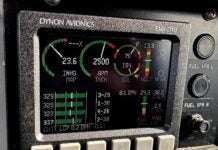
Let’s face it – when flying a cross-country in an RV (or other higher-performance experimental single that isn’t turbocharged), we like to think about cruising in the mid-teens… but unless you have a rip-roaring tailwind and oxygen, the airplanes are generally best between eight and twelve thousand. Well, things are a little different in the SubSonex. Limited by a lack of IFR capability to 17,999 feet, the little jet enjoys trips at 16.5K or 17.5K (assuming the trip is long enough to warrant the climb). Lower just burns more fuel, and you don’t go as fast – so a cruise-climb to the legal limit is generally the best option if you’re trying to maximize leg length. And, it’s a lot smoother and you can see farther from up there.
I frequently make the cruise up and down the eastern side of the Sierra Nevada from the Nevada side of Lake Tahoe down to Southern California, and doing it in the jet is now my favorite way to go. In total trip time, it’s a little longer, because I have to stop for fuel – but the views are tremendous, and it’s nice to get above the bumps caused by the wind rolling over the tops of the peaks. Yeah, the wave goes much higher, but the really nasty rollers seem to be down below 14,000 in the Owens Valley. Here are a few pictures from a recent trip – it’s hard to argue with those spectacular views.

But there is more than just the view that’s different – your whole way of thinking on a cross-country changes when you’re climbing to those levels. For one, you spend a much smaller percentage of your time in cruise. With a piston single, I climb to cruise altitude in fifteen or twenty minutes, then spend a couple of hours droning along there before short, fast descent (to spend as little time in the bumps as possible. In the jet, the climb portion is longer – partly because the climb rate is less, but more because I am going higher. It might take twenty to twenty-five minutes to settle in at 17.5K. Then with a total flight time limited to about two hours, the cruise portion of the flight might only be forty-five minutes before I trim the nose over to redline and pull the power back to flight idle, a long ways out from the destination. In fact, less time is spent in cruise than in climb and descent combined.
Fuel numbers are also a little wonky. Plan on seeing 36 gph on the takeoff and initial climb, then at 1,000′, you set up climb power at 25 – 27 gph (which drops off with a constant throttle setting as you gain altitude). By the time you reach cruise, you’re down to 20 gph or maybe a little less (between 18 and 19.5 is normal). The descent might flow fuel at a miserly ten or 12 gph, bringing a warm glow as your remaining range numbers climb – replacing that puckering feeling on climb when it appears you don’t have enough fuel to make your destination!

There are plenty of other differences we’ll talk about in the future – but I’ll leave you with one other for now – you get to meet a whole new group of people on the radio. When I called Joshua Approach this morning to transit through the Edwards complex of restricted airspace, he referred me to LA Center because “my airspace only goes up to 13,000.” That’s just never been an issue in my other planes.














